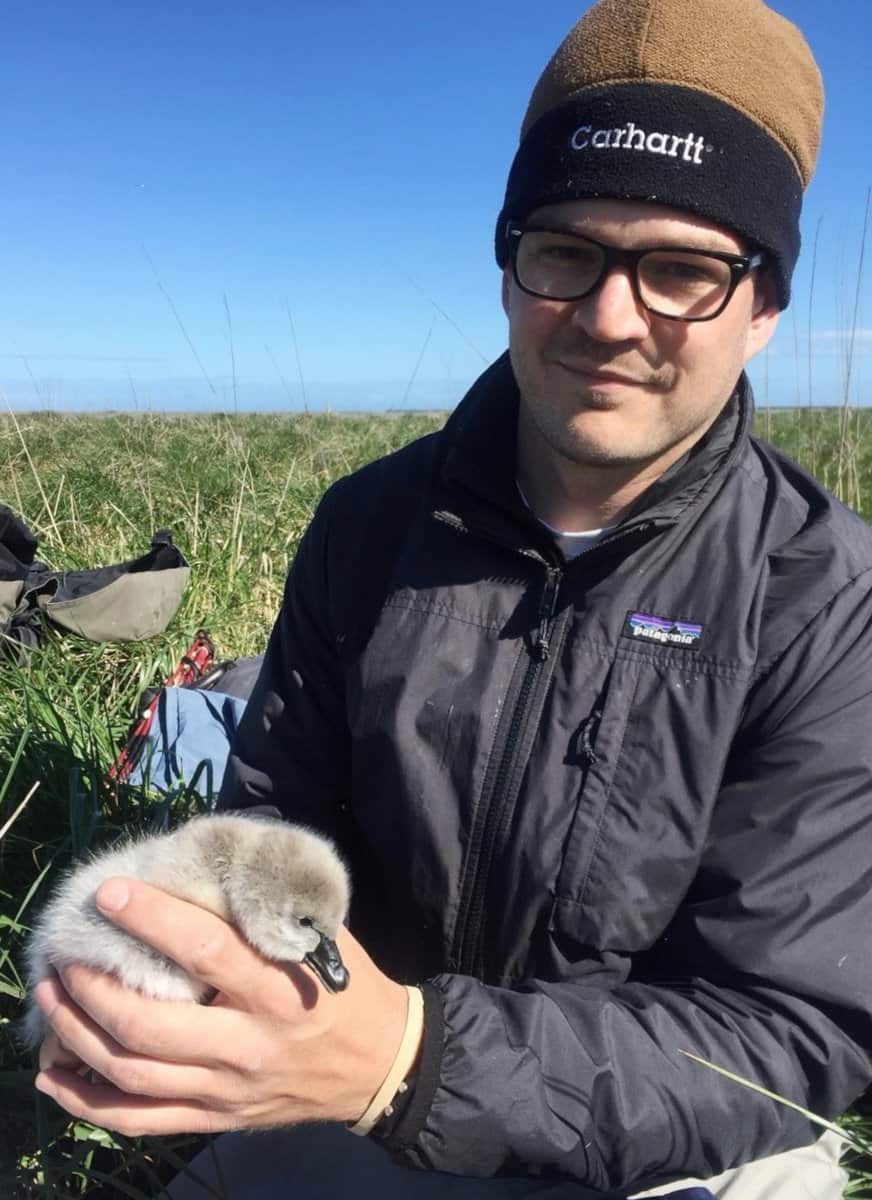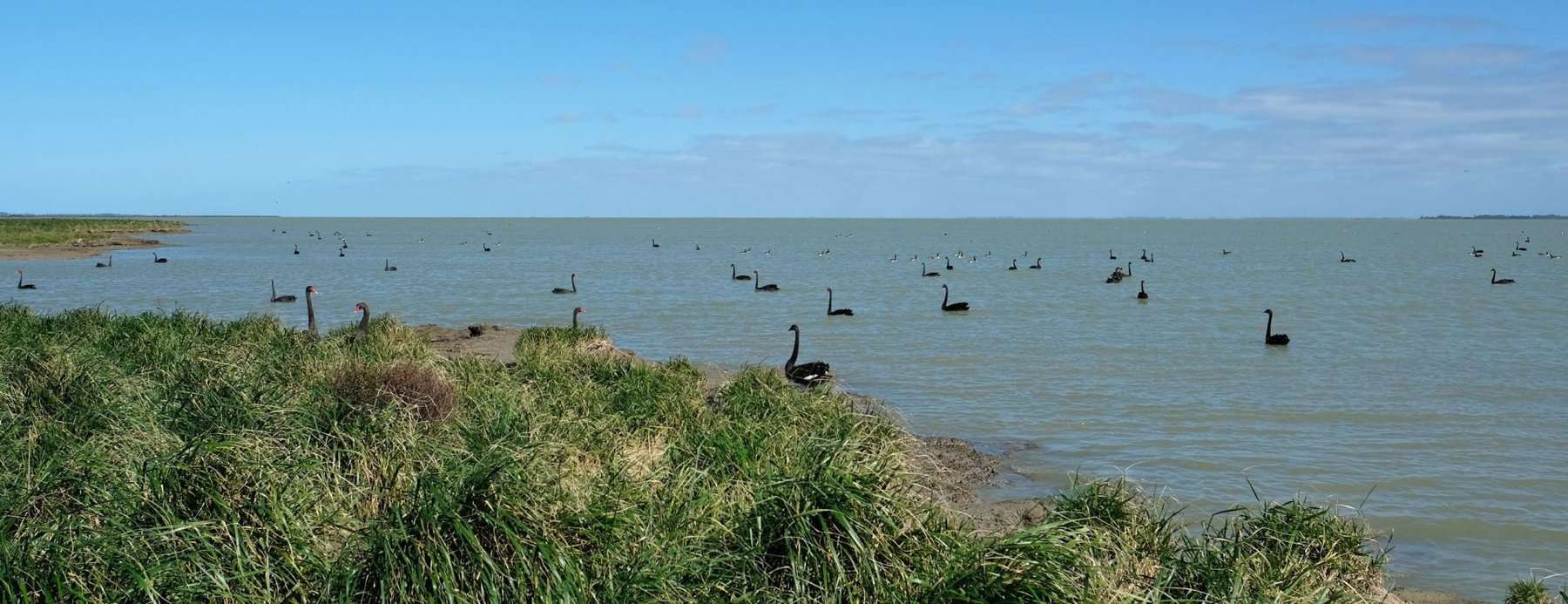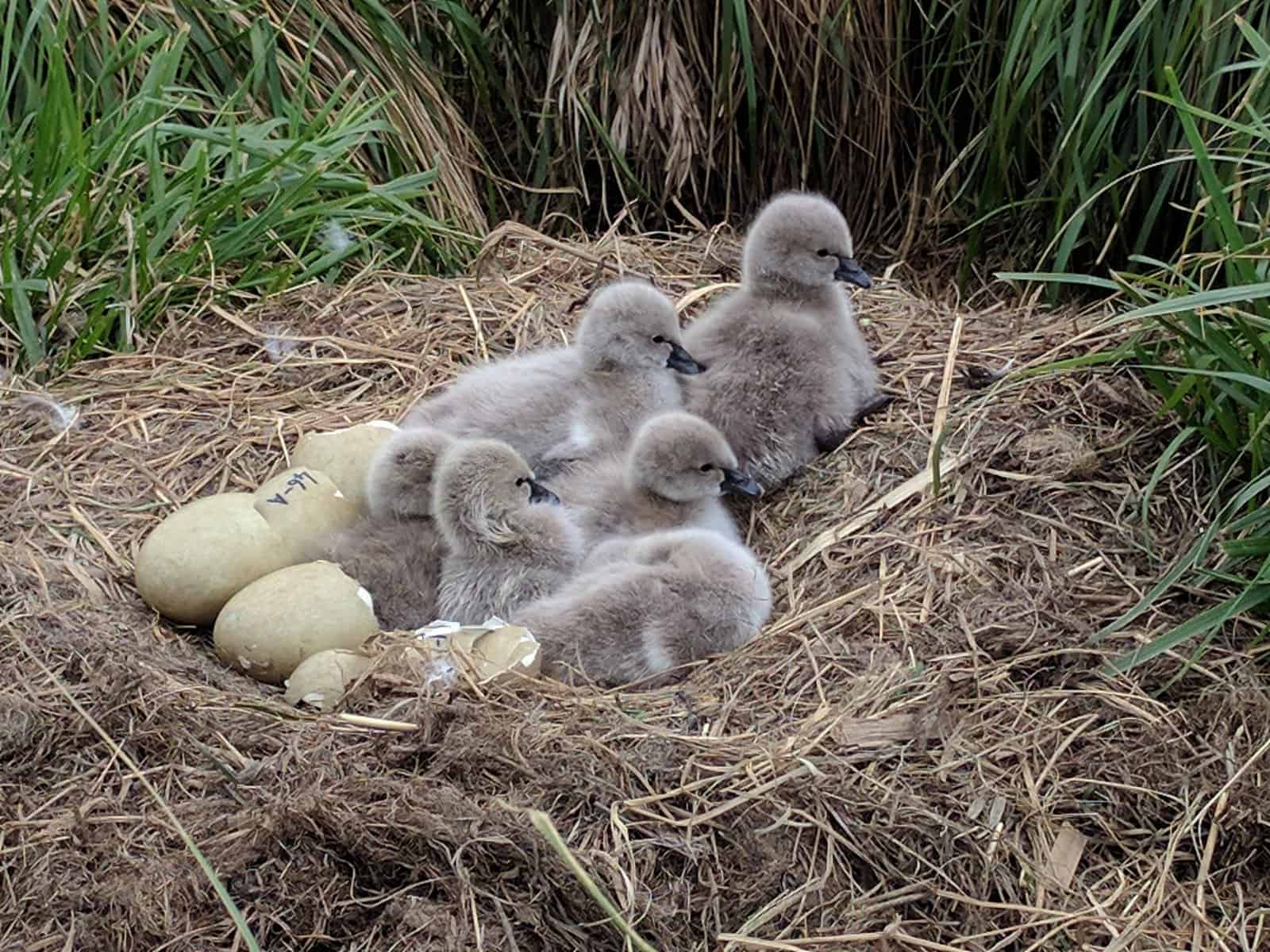Swans have long captured our imaginations and are well represented in visual arts and stories: from Crown Lynn, to Dreamtime (Nyungar people place swans in their genealogies), to exquisite art pieces symbolising the pursuit of Te Ara a Tāwhaki, created by Tahu Robinson (Ngāi Tahu, Ngāti Mamoe, Ngāti Apa ki Rā Tō, Te Whānau a Apanui, Ngāti Porou).
The swan genus (Cygnus) are a common sight along many waterways and lakes of the world, yet swans don’t have a straightforward history in Aotearoa, with their timeline complicated by extinction, natural self-introductions, introductions by Europeans, and waves of migrations.
The poūwa (Cygnus sumnerensis) was a swan species endemic to Aotearoa that diverged from kakī anau (black swan, Cygnus atratus) several million years ago, but they are believed to have gone extinct by 1450.
Kakī anau were likely naturalising in waves of migration, before introductions from Australia were organised by acclimatisation societies across Aotearoa. Their populations flourished, presumably due to kakī anau paddling into ecological niches left vacant by their poūwa cousins.
Their descendants are now commonplace, especially in lakes such as Te Waihora. Regardless of conventional classification (as naturalised or introduced), the contemporary population of kakī anau has a strong history here and represents a cultural analogue to poūwa, which restores an important component of te taiao otherwise lost to time.
At Te Waihora, generations of Ngāi Tahu people have gathered kakī anau eggs for nourishment and for craft, all the while monitoring the ecosystems to ensure the associated resources are future proofed.
Within many customary management systems, indigenous people continually engage with and monitor their environments, while over time accumulating long-term experiential knowledge of biodiversity and ecosystems at fine resolutions.
Mark Herse and co-authors

However, without special permission customary harvest is prohibited under government mandates overseen by Fish & Game NZ, despite the experiential knowledge offered by culturally invested iwi, hapū and whānau.
The lack of data informing current kakī anau management, as well as the inequity facing those looking to engage in customary harvest, were calls to action for the authors. The purpose of the study was clear: to gain evidence to support customary management and possible revisions to the regulations.
“Building on our previous experimental harvest study, which assessed adaptive harvest strategies at Te Waihora, we developed a new model to estimate sustainable population-level rates of egg harvest, and effects of background pressure from sport hunting.”
Classified as “game birds” under current New Zealand law, adult kakī anau can be legally hunted in most regions by landowners and anyone with a gamebird licence issued by Fish & Game NZ.
Historically, farmers concerned by kakī anau grazing on pastures intended for livestock in the North Canterbury Fish & Game region have been granted permits to perform culls.
Cull permits are no longer issued in this region, but single licence holders can shoot twenty adult birds a day during August at Te Waihora. This comes just before breeding season. During the North Canterbury game bird season (May to July) the bag limit is set at two kakī anau per day.

The paper’s findings show that populations of kakī anau are more sensitive to the survival of adults (the targets of hunts and culls) than to nesting success, and that unregulated taking of adults could cause population declines to the extent that sustainable customary egg harvest would be made impossible.
“The current kakī anau population at Te Waihora is only about 5 – 10% of what it was during the 1950s – 1960s,” says Mark. “A lot of people assume that black swans are everywhere and overpopulated but in fact the numbers have declined dramatically at Te Waihora, mostly due to the degradation of the lake by agricultural runoff, especially after the Wahine storm of 1968 wiped out a large proportion of the lake’s aquatic plants. The Te Waihora ecosystem never recovered from this event.
“There is irony in the fact some farmers don’t like kakī anau eating their pasture, considering part of the reason swans eat pasture is because farming has degraded the lake and the aquatic plants that swans would otherwise eat.”
The authors of the paper write that long-term scrutiny of customary egg harvest is unfounded. “Implementing customary management requires confronting cultural biases and power asymmetries against Indigenous peoples and local communities, and adopting equitable policies that empower them to engage with and protect their lands and resources in culturally appropriate ways.”
“Responding to the concerns of farmers, officials of North Canterbury Acclimatisation Society (NCAS) spent decades trying to limit swan breeding by destroying huge numbers of nests,” says Mark. “At the same time they collected eggs and supplied manufacturers of Ovaltine and racehorse food, all while prohibiting customary harvest by Ngāi Tahu, erecting guard towers around the breeding colonies. The money made from selling swan eggs was a major source of revenue for NCAS at the time. So, the policy to prohibit customary egg harvest was never really about conservation, it was about establishing control over the lake and its resources.”
The national perspective
The paper adds scholarship to an urgent movement to recognise the rights and interests of mana whenua in environmental management. It is joined by other researchers such as Karla Carey, who is exploring the language of kaitiakitanga, how government uses the word in policy, and whether it is incorporated into policy with the full intent to honour its meaning.
Navigating customary harvesting rights can feel like the wild west, with few written protections for resources and taonga created from te taiao by mana whenua. Today, if taonga, like a korowai (cloak), is created from materials taken from the conservation estate (for instance, from feathers of kakī anau) that item is owned by the Crown, and can be legally seized. The crown has never yet exercised this right, says Aroha Mead, Mātauranga Māori and Wai262 Advisor for BioHeritage. But the lack of protection is concerning.
“I’m happy to see more papers being published in the field of sustainable use as I feel it is a highly misunderstood but fundament element of successful conservation.”
Aroha Mead (Ngāti Awa, Ngāti Porou, Ngāti Tūwharetoa, Tuhourangi and Ngāi Tūhoe; BioHeritage Mātauranga Māori and Wai262 advisor)
In Ngā Rākau Taketake’s Oranga programme, researchers have also noted that current approaches to the conservation and protection of Indigenous flora, particularly seeds, don’t adequately reflect the aspirations and interests of Māori.
Equally, those creating policies and processes on Indigenous flora struggle to understand how to improve systems by actively, meaningfully and appropriately engaging with Māori.
The Oranga team are developing seed banking guidelines and protocols that affirm the cultural authority of Māori as custodians of native species and seeds, and delegate to Māori decision-making powers and functions across all aspects of seed banking.
Mark Herse’s paper details the ingenious ways he and his team sourced their data. ‘A demographic model to support customary management of a culturally important waterfowl species’ is available free to read and download here.
Mark was supervised by Jason Tylianakis (University of Canterbury) and was part of BioHeritage Tranche 1 project Customary Approaches to Ecosystem Resilience, co-led by Phil Lyver (Manaaki Whenua – Landcare Research) and Nigel Scott (Te Rūnanga o Ngāi Tahu).
– Kerry Donovan Brown
